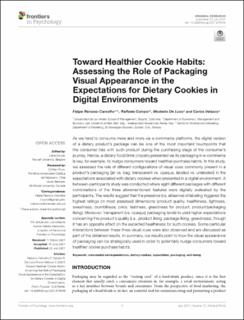Towards healthier cookie habits: Assessing the role of packaging visual appearance in the expectations for dietary cookies in digital environments
Peer reviewed, Journal article
Published version
Permanent lenke
https://hdl.handle.net/11250/3044218Utgivelsesdato
2021Metadata
Vis full innførselSamlinger
- Scientific articles [2181]
Sammendrag
As we tend to consume more and more via e-commerce platforms, the digital version
of a dietary product’s package can be one of the most important touchpoints that
the consumer has with such product during the purchasing stage of the consumer’s
journey. Hence, a dietary food/drink properly presented via its packaging in e-commerce
is key, for example, to nudge consumers toward healthier purchase habits. In this study,
we assessed the role of different configurations of visual cues commonly present in a
product’s packaging (jar vs. bag, transparent vs. opaque, labeled vs. unlabeled) in the
expectations associated with dietary cookies when presented in a digital environment. A
between-participants study was conducted where eight different packages with different
combinations of the three aforementioned features were digitally evaluated by the
participants. The results suggest that the presence (vs. absence) of labeling triggered the
highest ratings on most assessed dimensions (product quality, healthiness, lightness,
sweetness, crumbliness, price, tastiness, greediness for product, product/packaging
liking). Moreover, transparent (vs. opaque) packaging tends to yield higher expectations
concerning this product’s quality (i.e., product liking, package liking, greediness), though
it has an opposite effect on the expected healthiness for such cookies. Some particular
interactions between these three visual cues were also observed and are discussed as
part of the obtained results. In summary, our results point to how the visual appearance
of packaging can be strategically used in order to potentially nudge consumers toward
healthier cookie purchase habits.

